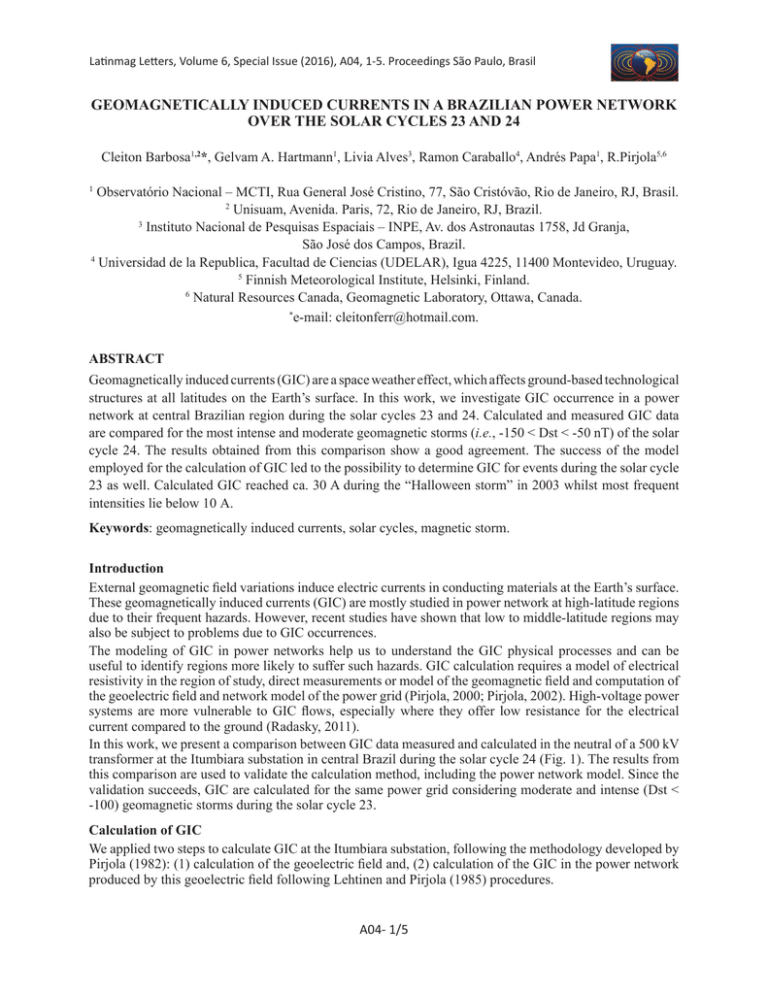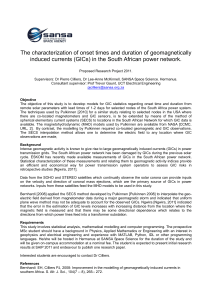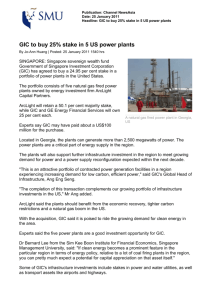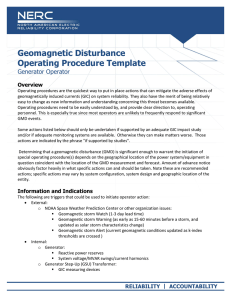geomagnetically induced currents in a brazilian power network over
advertisement

Latinmag Letters, Volume 6, Special Issue (2016), A04, 1-5. Proceedings São Paulo, Brasil GEOMAGNETICALLY INDUCED CURRENTS IN A BRAZILIAN POWER NETWORK OVER THE SOLAR CYCLES 23 AND 24 Cleiton Barbosa1,2*, Gelvam A. Hartmann1, Livia Alves3, Ramon Caraballo4, Andrés Papa1, R.Pirjola5,6 Observatório Nacional – MCTI, Rua General José Cristino, 77, São Cristóvão, Rio de Janeiro, RJ, Brasil. 2 Unisuam, Avenida. Paris, 72, Rio de Janeiro, RJ, Brazil. 3 Instituto Nacional de Pesquisas Espaciais – INPE, Av. dos Astronautas 1758, Jd Granja, São José dos Campos, Brazil. 4 Universidad de la Republica, Facultad de Ciencias (UDELAR), Igua 4225, 11400 Montevideo, Uruguay. 5 Finnish Meteorological Institute, Helsinki, Finland. 6 Natural Resources Canada, Geomagnetic Laboratory, Ottawa, Canada. * e-mail: cleitonferr@hotmail.com. 1 ABSTRACT Geomagnetically induced currents (GIC) are a space weather effect, which affects ground-based technological structures at all latitudes on the Earth’s surface. In this work, we investigate GIC occurrence in a power network at central Brazilian region during the solar cycles 23 and 24. Calculated and measured GIC data are compared for the most intense and moderate geomagnetic storms (i.e., -150 < Dst < -50 nT) of the solar cycle 24. The results obtained from this comparison show a good agreement. The success of the model employed for the calculation of GIC led to the possibility to determine GIC for events during the solar cycle 23 as well. Calculated GIC reached ca. 30 A during the “Halloween storm” in 2003 whilst most frequent intensities lie below 10 A. Keywords: geomagnetically induced currents, solar cycles, magnetic storm. Introduction External geomagnetic field variations induce electric currents in conducting materials at the Earth’s surface. These geomagnetically induced currents (GIC) are mostly studied in power network at high-latitude regions due to their frequent hazards. However, recent studies have shown that low to middle-latitude regions may also be subject to problems due to GIC occurrences. The modeling of GIC in power networks help us to understand the GIC physical processes and can be useful to identify regions more likely to suffer such hazards. GIC calculation requires a model of electrical resistivity in the region of study, direct measurements or model of the geomagnetic field and computation of the geoelectric field and network model of the power grid (Pirjola, 2000; Pirjola, 2002). High-voltage power systems are more vulnerable to GIC flows, especially where they offer low resistance for the electrical current compared to the ground (Radasky, 2011). In this work, we present a comparison between GIC data measured and calculated in the neutral of a 500 kV transformer at the Itumbiara substation in central Brazil during the solar cycle 24 (Fig. 1). The results from this comparison are used to validate the calculation method, including the power network model. Since the validation succeeds, GIC are calculated for the same power grid considering moderate and intense (Dst < -100) geomagnetic storms during the solar cycle 23. Calculation of GIC We applied two steps to calculate GIC at the Itumbiara substation, following the methodology developed by Pirjola (1982): (1) calculation of the geoelectric field and, (2) calculation of the GIC in the power network produced by this geoelectric field following Lehtinen and Pirjola (1985) procedures. A04- 1/5 Latinmag Letters, Volume 6, Special Issue (2016), A04, 1-5. Proceedings São Paulo, Brasil Figure 1. The 500 kV power network investigated in this paper and located in central Brazil. The transmission lines shown in blue were installed in 2006. Calculation of the geoelectric field We used the plane wave model in Cartesian coordinate system (Cagniard, 1953; Pirjola, 1982) to calculate the geoelectric field (GEOF). In the plane wave approximation, the time series corresponding to geomagnetic data is Fourier transformed to the frequency domain, and then the geoelectric northward (Ex) and eastward (Ey) components are obtained from the following relation: (1) Where Z (w) is the surface impedance in function of the (angular) frequency w and on the Earth’s conductivity structure, and By,x are the geomagnetic eastward and northward components, respectively. Once the Ex and Ey components are obtained in the frequency domain from Eq. (1), they are converted to the time domain by the application of an inverse Fourier transform. In this study, we use a ground conductivity model obtained from magnetotelluric surveys, as described by Bologna et al. (2001). It consists of four layers, with the deepest layer being infinitely thick, and approximates to the local geology in the area of the 500 kV power network shown in Figure 1. The magnetic observatory closest to the Itumbiara substation is located in Vassouras, Rio de Janeiro State, (VSS, 22.4oS, 43.6oW, and see Figure 1). The distance between VSS and Itumbiara is about 740 km considered reasonable to use VSS dataset in this work since geomagnetic field morphology and time variations are not so different between VSS and Itumbiara substation (Trivedi et al., 2007). GIC modelling using the Lehtinen-Pirjola (LP) method The (geo)voltage between two points i and j at the Earth’s surface, can be calculated by integrating GEOF along the trajectory, which, is the transmission line between i and j: A04 - 2/5 Latinmag Letters, Volume 6, Special Issue (2016), A04, 1-5. Proceedings São Paulo, Brasil (2) The power grid is modelled as a network of N earthed substations (i.e., nodes) interconnected by transmission lines with voltage sources in series with the line resistances. In the LP method, the GIC flowing into the ground at the nodes are expressed as an N X 1 column matrix Ie (Lehtinen and Pirjola 1985): (3) where Id is the N X N identity matrix, YN is the N X N network admittance matrix with their elements given by: is the resistance of the line between nodes i and j and the diagonal elements being the earthing resistances (4) is the N X N earthing impedance matrix with of the nodes: (5) If the earthing points are far apart (as in case of different substations), the off-diagonal elements of Ze are zero. The elements of the N X 1 column matrix are defined by: (j = 1, … , N) (6) Je thus includes the information about the geovoltages Vij. Since Ie = Je in the case of perfect earthings of the nodes, (i.e., Ze = 0), the elements of Je can be interpreted as “perfect earthing currents”. Results and discussion In order to compare the measured and calculated GIC results, we choose three most intense geomagnetic storm events. They are included in the panels (a) 16 June 2012, (b) 2 October 2013 and (c) 8 October 2013 of Figure 2, where the blue and red curves depict the calculated and measured GIC, respectively. The peaks have a good agreement in the calculated and measured GIC data. Regarding specifically the event on 2 October 2013 (Figure 2b), the curves are also similar when the GIC values are smaller, so a good agreement between calculations and measurements holds true most of the time. We suggest that the small discrepancies at low amplitudes of GIC can be related to local ionospheric instabilities. The general behavior observed in comparison between calculated and measured GIC data indicates that the calculations are reliable and can thus be applied to the determination of GIC at the Itumbiara substation during periods with no measurements available. The GIC for large magnetic storms (Dst < - 100 nT, total of 90 events) that occurred during solar cycle 23 (listed in Pandey, 2009) was calculated for the day when the Dst reaches its minimum value, the day previous and the day after. Figure 3 shows the daily maximum amplitudes of calculated GIC versus maximum decreases in Dst value. We observe that several storms (moderate intensity) can cause GIC values higher than 10 A and a few (intense) storms can also lead to more than 20 A. The highest GIC amplitudes obtained at the Itumbiara power network, during solar cycle 23 was 30 A, during the Halloween storm (Dst = -401 nT). However, to illustrate the complexity of the phenomena involved in the GIC generation, it is observed in Figure 3 two geomagnetic storms producing Dst higher than -400 nT. For these two storms were observed GIC values ca. 30 A and 15 A, respectively. This important difference is observed because GIC could have other contributions that are not properly described by Dst index amplitude. A04- 3/5 Latinmag Letters, Volume 6, Special Issue (2016), A04, 1-5. Proceedings São Paulo, Brasil (a) (b) (c) Figure 2. Calculated (blue) and measured (red) GIC in the neutral of the Itumbiara 500 kV transformer on (a) 16 June 2012, (b) 2 October 2013, (c) 8 October 2013. A04 - 4/5 Latinmag Letters, Volume 6, Special Issue (2016), A04, 1-5. Proceedings São Paulo, Brasil Figure 3. Daily maximum amplitude of GIC in the neutral of the Itumbiara 500 kV transformer versus the intensity of the magnetic storm on solar cycle 23. References Bologna, M. S., Padilha, A. L., Vitorello, I., 2001. Geophysical signature of the deep lithosphere underlying the Alto Paranaíba igneous province: Constraining upper mantle properties, Rev. Bras. Geocienc., 31, 471-474. Cagniard, L., 1953. Basic theory of the magneto-telluric method of geophysical prospecting. Geophysics, 18, 605-635. doi: 10.1190/1.1437915 Lehtinen, M., Pirjola, R., 1985. Currents produced in earthed conductor networks by geomagneticallyinduced electric fields. Ann. Geophys., 3, 479-484. Pirjola, R., 1982. Electromagnetic induction in the earth by a plane wave or by fields of line currents harmonic in time and space. Geophysica, 18, 1-161. Pirjola, R., 2000. Geomagnetically induced currents during magnetic storms. IEEE Trans. Plasma Sci., 28, 1867-1873. doi: 10.1109/27.902215 Pirjola, R., 2002. Review On The Calculation Of Surface Electric And Magnetic Fields And Of Geomagnetically Induced Currents In Ground-Based Technological Systems. Surv. Geophys., 23, 71-90. doi: 10.1023/A:1014816009303 Radasky, W. A., 2011. Overview of the Impact of Intense Geomagnetic Storms on the U.S. High Voltage Power Grid. 2011 IEEE International Symposium on Electromagnetic Compatibility, 6038326, 300-305, 11-19 August 2011, Long Beach, United States. A04- 5/5





